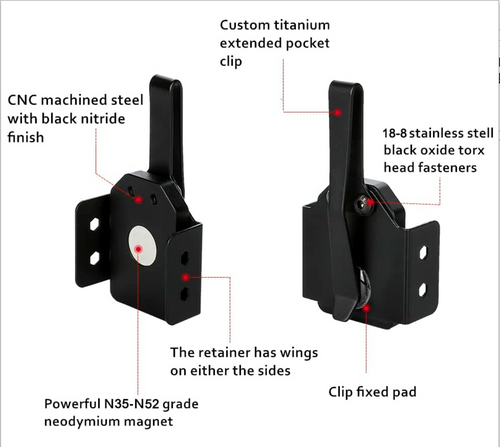Carrying concealed requires more than just owning a holster. To stay prepared and safe, focus on three key areas: safety, concealment, and movement. Here's a quick breakdown:
- Safety First: Always follow strict firearm safety rules.
- Concealment Basics: Choose the right holster (e.g., Houdini Holsters Breakout 2.0 IWB), wear loose-fitting clothing, and practice staying discreet.
- Movement Skills: Learn smooth transitions, maintain control during movement, and practice drawing from concealment.
Quick Tips:
- Use drills to build muscle memory for concealed draw and movement.
- Practice moving while shooting - forward, lateral, diagonal, and backward.
- Maintain your gear with daily inspections and regular cleaning.
This guide will walk you through essential techniques, drills, and gear maintenance to enhance your concealed carry training. Let’s dive in!
How To Train With Your Concealed Carry Pistol
Concealment Basics
Getting concealment right depends on choosing the right holster, wearing suitable clothing, and sticking to consistent carrying habits.
Holster Selection Guide
A good holster makes all the difference. Take the Houdini Holsters Breakout 2.0 IWB holster, which debuted in January 2024. It checks all the boxes:
- Comfortable enough for all-day wear
- Secure retention while allowing quick access
- Reduces visible firearm outline (minimal printing)
- Reliable, smooth draw every time
"Want a Holster So Comfortable, You'll Forget It's Even There?"
A survey from its launch showed that 95% of users were satisfied with its comfort during extended wear.
Once you've got the right holster, the next step is choosing clothing that works with it.
Clothing for Concealed Carry
Your clothing can make or break your concealment efforts. Opt for cover garments like loose-fitting shirts or jackets to mask the outline of your firearm. Moisture-wicking undershirts are also a smart choice - they help stabilize your setup and keep things discreet.
But concealment isn't just about gear; it's also about how you carry yourself.
Daily Concealment Methods
Practice is key to staying concealed. Pay attention to your carry position during everyday movements to ensure it stays natural and hidden. Regularly practice drawing from concealment with different outfits, and build muscle memory through one-handed drills and dry-fire exercises.
Movement Skills
Once you've got the basics of concealment down, the next step is refining your movement skills. These skills are essential for staying prepared and safe while carrying concealed. A dependable holster plays a big role here, ensuring smooth draws and stable movement.
Draw and Move Techniques
Movement starts with a solid stance and proper holster use. Here are some key principles to practice:
- Keep your strong arm close to your body for control.
- Slightly bend your knees to maintain a stable platform.
- Move smoothly - avoid sudden, jerky actions.
- Work on transitioning seamlessly between different directions.
Cover Position Skills
When shifting between cover positions, it's critical to stay concealed while keeping your firearm accessible. Focus on these elements:
- Scan your surroundings before moving to a new position.
- Move unpredictably to make yourself harder to track.
- Use natural obstacles for temporary concealment when possible.
- Practice transitioning smoothly between standing and crouching.
Once you’re comfortable with these, combine them with dynamic shooting movements for a more complete skill set.
Moving and Shooting
Combining movement with shooting takes practice and the right equipment. Start with these basic movement patterns:
- Forward movement: Take short, controlled steps while keeping your upper body steady.
- Lateral movement: Step sideways without crossing your feet.
- Diagonal movement: Blend forward steps with lateral shifts for versatile positioning.
- Rearward movement: Take small, careful steps backward to maintain balance.
Practice these drills in a controlled environment to build confidence and consistency.
sbb-itb-7fb5bb8
Practice Drills
Practice drills help develop muscle memory and improve your reaction time. These exercises build on earlier skills like concealment and movement, sharpening your readiness for real-world situations.
Concealed Draw Practice
Start by working on your concealed draw with slow, deliberate movements to ensure proper technique. Once you've mastered the basics, practice drawing from different positions that mimic everyday scenarios. Using tools like the Houdini Holsters Breakout 2.0 can make your concealed draw smoother and more efficient.
Moving Target Practice
Take your draw and movement skills to the next level by practicing with moving targets. Work on advancing, shifting sideways, and maneuvering around obstacles - all while maintaining accuracy and staying concealed. Keep your focus on the target as you balance speed and precision.
Multiple Target Skills
Improve your ability to handle multiple targets by practicing in a controlled environment. Begin by engaging one target at a time, then gradually practice transitioning smoothly between targets. Stay focused on maintaining your posture and concealment throughout these drills.
Equipment Guide
Selecting and maintaining the right equipment is essential for successful concealment and movement training. The proper gear not only boosts safety but also improves your overall performance during practice.
Choosing Your Holster
When selecting a holster, prioritize features that enhance both functionality and comfort. For example, the Houdini Holsters' Breakout 2.0 IWB holster offers a patent-pending design that allows for quick access while ensuring full concealment. It’s tailored to fit models like Glock, Beretta, and Ruger. Key features to look for in a holster include:
- A secure retention system
- Full trigger guard coverage
- Adjustable cant for a personalized draw angle
- A sweat guard to protect your firearm
- Durable materials that maintain their shape over time
Remember, your holster is just one part of your overall setup. The following gear further supports your concealment and movement training.
Required Gear List
To create a complete setup for concealment and training, you’ll need more than just a holster. Here’s a breakdown of essential items:
| Equipment Category | Essential Items | Purpose |
|---|---|---|
| Support Gear | Gun belt, Magazine carrier, Training magazines | Provides stability and practice options |
| Protective Equipment | Eye protection, Ear protection, Shooting gloves | Keeps you safe during live-fire training |
| Clothing | Cover garments, Loose-fitting shirts, Training pants with belt loops | Ensures effective concealment during practice |
| Training Aids | Shot timer, Target stands, Training targets | Helps measure performance and offer feedback |
Equipment Care
Taking care of your gear is just as important as choosing it. Follow these simple maintenance practices to keep your equipment reliable:
-
Daily Inspection
Check your holster for any signs of wear, such as loose stitching or weakened retention. Make sure attachment points and clips are secure. -
Weekly Maintenance
Clean your holster with a soft brush to remove dirt or debris. If you use a leather holster, apply a leather conditioner every few months to prevent cracking. -
Monthly Assessment
Conduct a thorough inspection of all your gear:- Test the strength of your gun belt and buckle.
- Ensure your magazine carrier provides proper retention.
- Tighten adjustment screws to maintain the correct tension.
- Examine clothing for wear patterns that could impact concealment.
Regular upkeep ensures your equipment performs as intended, keeping you prepared for any training scenario.
Training Schedule
A clear training schedule helps sharpen your movement and concealment techniques. Here's how to structure your sessions across different practice settings.
No-Ammo Practice
Dedicate 15-20 minutes, three times a week, to dry drills:
| Time Block | Focus Area | Key Elements |
|---|---|---|
| 5 minutes | Draw stroke | Grip, smooth presentation, sight alignment |
| 5 minutes | Movement patterns | Side steps, diagonal movement, position shifts |
| 5 minutes | Target transitions | Engaging multiple targets, tracking sights |
| 5 minutes | Holster work | Safe re-holstering, adjusting concealment |
Always ensure your firearm is unloaded and pointed in a safe direction. Stick to your usual holster setup for consistency.
Once you’re confident with these drills, move on to live-fire training at the range.
Range Training
1. Warm-up Phase
Start with marksmanship drills at 3-5 yards. Focus on grip, trigger control, and sight alignment before adding complexity.
2. Skills Development
Build your skills with progressively harder exercises:
- Drawing from concealment for single targets
- Moving while maintaining a clear sight picture
- Engaging multiple targets
- Shooting at varying distances (3-15 yards)
3. Cool-down Phase
Wrap up with precision shots at 7-10 yards to reinforce accuracy and fundamentals.
Take it a step further by adding scenario-based drills to your routine.
Situation Practice
Every two weeks, integrate scenario-based training into your schedule. Emphasize:
- Environmental Awareness: Stay alert and scan while remaining concealed
- Movement Patterns: Practice navigating around obstacles like doorways, corners, and vehicles
- Communication Skills: Use clear verbal commands from ready positions
- Decision Making: Set up drills that require quick threat evaluations
Switch up your practice conditions regularly:
- Use different lighting setups
- Experiment with various cover garments
- Start from multiple positions
- Practice with different holster carry positions
Keep a training log to track your draw times, accuracy, and areas that need work. Reviewing this data will help you fine-tune your sessions and monitor your progress effectively.
Summary
Building expertise in concealment and movement takes consistent practice and reliable equipment. A well-rounded training routine - combining dry-fire exercises, range sessions, and scenario-based drills - sharpens the skills necessary for concealed carry. This approach not only improves your abilities but also ensures you get the most out of your gear.
Having the right equipment matters. The Houdini Holsters Breakout 2.0 IWB holster, with its patent-pending design, provides comfort, quick access, and dependable concealment. Plus, it comes with a lifetime guarantee, making it a solid choice for daily carry and training.
Caring for your equipment is just as important as choosing the right gear. To keep everything in top shape:
- Practice your draw consistently.
- Check your holster and firearm before every session.
- Clean your gear after each trip to the range.
Combining regular training with dependable gear sets the stage for effective concealed carry. Staying consistent with your practice and maintaining your equipment ensures you remain prepared over the long term.




